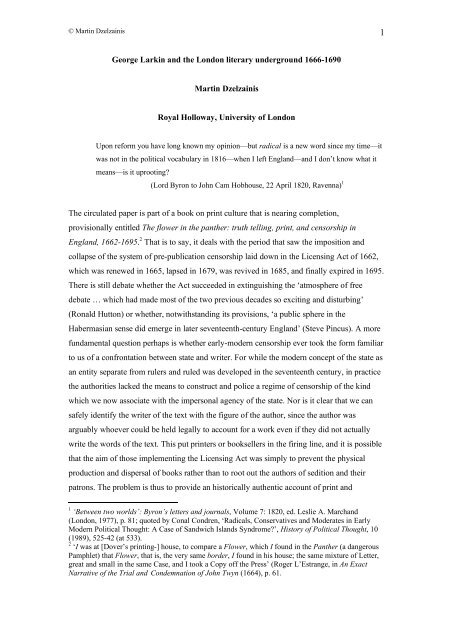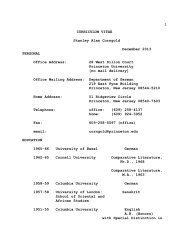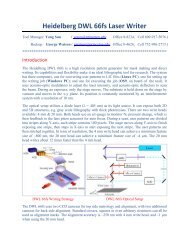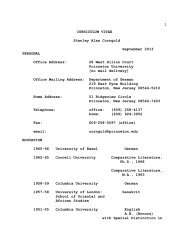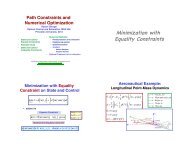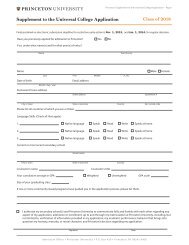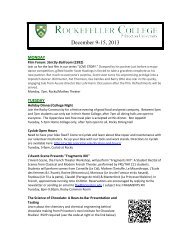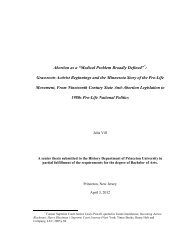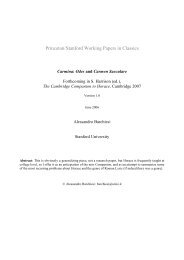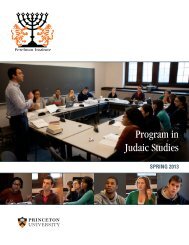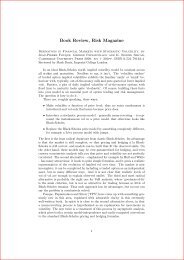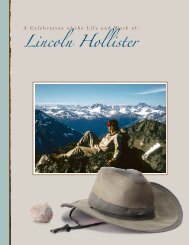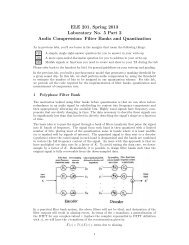George Larkin and the London literary underground 1666-1690 ...
George Larkin and the London literary underground 1666-1690 ...
George Larkin and the London literary underground 1666-1690 ...
Create successful ePaper yourself
Turn your PDF publications into a flip-book with our unique Google optimized e-Paper software.
© Martin Dzelzainis 1<br />
<strong>George</strong> <strong>Larkin</strong> <strong>and</strong> <strong>the</strong> <strong>London</strong> <strong>literary</strong> <strong>underground</strong> <strong>1666</strong>-<strong>1690</strong><br />
Martin Dzelzainis<br />
Royal Holloway, University of <strong>London</strong><br />
Upon reform you have long known my opinion—but radical is a new word since my time—it<br />
was not in <strong>the</strong> political vocabulary in 1816—when I left Engl<strong>and</strong>—<strong>and</strong> I don’t know what it<br />
means—is it uprooting?<br />
(Lord Byron to John Cam Hobhouse, 22 April 1820, Ravenna) 1<br />
The circulated paper is part of a book on print culture that is nearing completion,<br />
provisionally entitled The flower in <strong>the</strong> pan<strong>the</strong>r: truth telling, print, <strong>and</strong> censorship in<br />
Engl<strong>and</strong>, 1662-1695. 2 That is to say, it deals with <strong>the</strong> period that saw <strong>the</strong> imposition <strong>and</strong><br />
collapse of <strong>the</strong> system of pre-publication censorship laid down in <strong>the</strong> Licensing Act of 1662,<br />
which was renewed in 1665, lapsed in 1679, was revived in 1685, <strong>and</strong> finally expired in 1695.<br />
There is still debate whe<strong>the</strong>r <strong>the</strong> Act succeeded in extinguishing <strong>the</strong> ‘atmosphere of free<br />
debate … which had made most of <strong>the</strong> two previous decades so exciting <strong>and</strong> disturbing’<br />
(Ronald Hutton) or whe<strong>the</strong>r, notwithst<strong>and</strong>ing its provisions, ‘a public sphere in <strong>the</strong><br />
Habermasian sense did emerge in later seventeenth-century Engl<strong>and</strong>’ (Steve Pincus). A more<br />
fundamental question perhaps is whe<strong>the</strong>r early-modern censorship ever took <strong>the</strong> form familiar<br />
to us of a confrontation between state <strong>and</strong> writer. For while <strong>the</strong> modern concept of <strong>the</strong> state as<br />
an entity separate from rulers <strong>and</strong> ruled was developed in <strong>the</strong> seventeenth century, in practice<br />
<strong>the</strong> authorities lacked <strong>the</strong> means to construct <strong>and</strong> police a regime of censorship of <strong>the</strong> kind<br />
which we now associate with <strong>the</strong> impersonal agency of <strong>the</strong> state. Nor is it clear that we can<br />
safely identify <strong>the</strong> writer of <strong>the</strong> text with <strong>the</strong> figure of <strong>the</strong> author, since <strong>the</strong> author was<br />
arguably whoever could be held legally to account for a work even if <strong>the</strong>y did not actually<br />
write <strong>the</strong> words of <strong>the</strong> text. This put printers or booksellers in <strong>the</strong> firing line, <strong>and</strong> it is possible<br />
that <strong>the</strong> aim of those implementing <strong>the</strong> Licensing Act was simply to prevent <strong>the</strong> physical<br />
production <strong>and</strong> dispersal of books ra<strong>the</strong>r than to root out <strong>the</strong> authors of sedition <strong>and</strong> <strong>the</strong>ir<br />
patrons. The problem is thus to provide an historically au<strong>the</strong>ntic account of print <strong>and</strong><br />
1 ‘Between two worlds’: Byron’s letters <strong>and</strong> journals, Volume 7: 1820, ed. Leslie A. March<strong>and</strong><br />
(<strong>London</strong>, 1977), p. 81; quoted by Conal Condren, ‘Radicals, Conservatives <strong>and</strong> Moderates in Early<br />
Modern Political Thought: A Case of S<strong>and</strong>wich Isl<strong>and</strong>s Syndrome?’, History of Political Thought, 10<br />
(1989), 525-42 (at 533).<br />
2 ‘I was at [Dover’s printing-] house, to compare a Flower, which I found in <strong>the</strong> Pan<strong>the</strong>r (a dangerous<br />
Pamphlet) that Flower, that is, <strong>the</strong> very same border, I found in his house; <strong>the</strong> same mixture of Letter,<br />
great <strong>and</strong> small in <strong>the</strong> same Case, <strong>and</strong> I took a Copy off <strong>the</strong> Press’ (Roger L’Estrange, in An Exact<br />
Narrative of <strong>the</strong> Trial <strong>and</strong> Condemnation of John Twyn (1664), p. 61.
© Martin Dzelzainis 2<br />
censorship at precisely <strong>the</strong> point when some of <strong>the</strong> categories we now regard as crucial to<br />
such an account – <strong>the</strong> author <strong>and</strong> <strong>the</strong> state – were in <strong>the</strong> process of being developed <strong>and</strong><br />
articulated. In short, <strong>the</strong> book addresses <strong>the</strong> question of why <strong>the</strong> restored monarchy proved<br />
unable to institute what Henri-Jean Martin calls a ‘typographical absolutism’ of <strong>the</strong> kind<br />
associated with Richelieu <strong>and</strong> Colbert. 3<br />
The chapter in <strong>the</strong> book on <strong>the</strong> role of printers in <strong>the</strong> production <strong>and</strong> distribution of<br />
seditious texts of course discusses <strong>the</strong> three who were executed in <strong>the</strong> second half of <strong>the</strong><br />
seventeenth century: John Twyn (1664), William Disney (1685), <strong>and</strong> William Anderton<br />
(1693). The case of Anderton, who was executed for printing two Jacobite texts, is<br />
particularly damaging to <strong>the</strong> whiggish assumption that <strong>the</strong> Williamite regime of <strong>the</strong> <strong>1690</strong>s<br />
was somehow more benign in its intentions towards <strong>the</strong> press than its predecessors. But <strong>the</strong>se<br />
are relatively uncomplicated cases, which is why I’m interested in <strong>George</strong> <strong>Larkin</strong> (c.1642-<br />
1707), a printer, bookseller <strong>and</strong> author who has been overlooked in st<strong>and</strong>ard accounts of <strong>the</strong><br />
<strong>London</strong> <strong>literary</strong> <strong>underground</strong>. He does not feature in Neil Keeble’s Literary culture of<br />
nonconformity, or <strong>the</strong> DNB or, more surprisingly, <strong>the</strong> Biographical dictionary of British<br />
radicals in <strong>the</strong> seventeenth century, edited by Greaves <strong>and</strong> Zaller. Yet even a glance at <strong>the</strong> list<br />
of works he printed – from John Bunyan’s Grace abounding (<strong>1666</strong>) to Henry Care’s<br />
Animadversions upon mijn heer Fagels letter (1688) – suggests that he should be considered<br />
alongside <strong>the</strong> likes of John Darby or Francis Smith. An account of <strong>Larkin</strong>’s activities in <strong>the</strong><br />
1660s, 1670s, <strong>and</strong> 1680s in fact encapsulates <strong>the</strong> major turning-points in <strong>the</strong> development of<br />
print culture under <strong>the</strong> later Stuarts. At <strong>the</strong> same time, his career calls into question our notion<br />
of what a seventeenth-century British radical was like – if such an animal ever existed.<br />
We should remember, as my epigraph from Lord Byron makes clear, that ‘radical’<br />
was a term which did not even enter <strong>the</strong> ‘political vocabulary’ until <strong>the</strong> nineteenth century. To<br />
describe any early-modern person as a radical is thus to run <strong>the</strong> risk of gross anachronism. We<br />
need to bear in mind at all times our propensity to convert <strong>the</strong> past ‘into a version of present<br />
verities’. O<strong>the</strong>rwise, as Conal Condren has remarked, history does indeed become a pack of<br />
tricks we play upon <strong>the</strong> dead. 4 Richard Greaves concedes <strong>the</strong> terminology is anachronistic but<br />
insists it is useful for historians, providing care is taken not to ‘read back modern notions of<br />
“radicalism” into <strong>the</strong> age of Charles II <strong>and</strong> James II’. But in that that case, what does Greaves<br />
mean by <strong>the</strong> term? It certainly involves much more than dissent from <strong>the</strong> powers that be: ‘<strong>the</strong><br />
mere act of opposing a regime is not enough to make one a radical; <strong>the</strong> advocacy or<br />
implementation of revolutionary goals is <strong>the</strong> determining factor’. Radicals were those ‘who<br />
3 Henri-Jean Martin, The French Book: Religion, Absolutism, <strong>and</strong> Readership, 1585-1715, trans. by<br />
Paul Saenger <strong>and</strong> Nadine Saenger (Baltimore <strong>and</strong> <strong>London</strong>, 1996), p. 37.<br />
4 Condren, ‘Radicals , conservatives <strong>and</strong> moderates’, 527-8.
© Martin Dzelzainis 3<br />
espoused active disobedience of <strong>the</strong> law, particularly in <strong>the</strong> form of such activities as<br />
rebellion, assassination, <strong>the</strong> publication of allegedly seditious literature, <strong>and</strong> <strong>the</strong> use of<br />
violence to prevent legally constituted authorities from enforcing <strong>the</strong> law’. 5 At first sight,<br />
placing publishing on a par with o<strong>the</strong>r activities such as rebellion <strong>and</strong> assassination seems an<br />
obvious instance of what we are supposed to avoid: <strong>the</strong> imposition of our sense of priorities<br />
upon those of <strong>the</strong> past. But in this case it would be true to say that this was also <strong>the</strong><br />
seventeenth-century view of <strong>the</strong> matter, or, more precisely, <strong>the</strong> view of those in authority.<br />
Looked at in this light, what kind of “radical” was <strong>George</strong> <strong>Larkin</strong>? By way of answering that<br />
question, I’ll give a brief resume of his career in successive decades.<br />
First <strong>the</strong> 1660s. <strong>Larkin</strong> began his career in <strong>1666</strong> by printing <strong>the</strong> first edition of Bunyan’s<br />
Grace abounding. According to Christopher Hill, who thinks that ‘Bunyan chose his printers<br />
*<br />
because of <strong>the</strong>ir radicalism’, <strong>the</strong> job was only assigned to <strong>Larkin</strong> because his usual publisher,<br />
<strong>the</strong> Baptist Francis Smith, was subject to searches. 6 Presumably, <strong>Larkin</strong> came into contact<br />
with Bunyan or Smith through <strong>the</strong> dissenting community (<strong>Larkin</strong> belonged to a congregation<br />
at Clerkenwell Green). After this, <strong>Larkin</strong> went completely <strong>underground</strong>, printing Ralph<br />
Wallis’s Room for <strong>the</strong> cobler of Gloucester <strong>and</strong> his wife with several cartloads of abominable<br />
irregular, pitiful stinking priests, an anticlerical satire, <strong>and</strong> more significantly, Andrew<br />
Marvell’s Second advice to a painter <strong>and</strong> Third advice to a painter, poems which effectively<br />
inaugurated <strong>the</strong> tradition of state satire. Once again, Smith was probably involved, having<br />
tried to get <strong>the</strong> Advices printed in July 1667.<br />
<strong>Larkin</strong> was <strong>the</strong>n caught up in a series of searches in Southwark in 1668. When Roger<br />
Norton searched his house ‘for <strong>the</strong> bookes stiled The Cobbler of Gloucester <strong>and</strong> Advice to <strong>the</strong><br />
Painter) [<strong>Larkin</strong>] fled out of <strong>the</strong> back doore <strong>and</strong> escaped, but he found seuerall of <strong>the</strong> s d<br />
Bookes’. 7 A printing press was also seized at <strong>the</strong> house of Elizabeth Poole (presumably <strong>the</strong><br />
interregnum radical of that name) in a set of tenements known as <strong>the</strong> Mint, one of <strong>the</strong> so-<br />
called “liberties”, located west of St <strong>George</strong>’s parish church, itself just below <strong>the</strong> King’s<br />
Bench prison. Poole plausibly claimed to know nothing of <strong>the</strong> comings <strong>and</strong> goings of her<br />
tenant who had set up <strong>the</strong> press in a garret. The unnamed printer was not even arrested.<br />
Elizabeth Calvert (<strong>the</strong> widow of Giles) was apprehended in <strong>the</strong> raid <strong>and</strong> committed to <strong>the</strong><br />
Gatehouse for keeping a press <strong>and</strong> ‘for vending & publishing unlicensed & Sc<strong>and</strong>alous<br />
5<br />
Greaves, Enemies under his feet: radicals <strong>and</strong> nonconformists in Britain, 1664-1677 (Stanford, CA,<br />
1990), pp. vii-viii.<br />
6<br />
See Christopher Hill, A turbulent, seditious, <strong>and</strong> factious people: John Bunyan <strong>and</strong> his church<br />
(Oxford, 1988), pp. 287-91. But Hill too neglects <strong>Larkin</strong> – strangely, given that <strong>Larkin</strong> published<br />
ano<strong>the</strong>r six works by Bunyan in 1688 to 1689 (Wing B5480, B5510, B5522, B5545, B5549, <strong>and</strong><br />
B5595). <strong>Larkin</strong> is not mentioned at all in Bunyan, Grace abounding <strong>and</strong> o<strong>the</strong>r spiritual<br />
autobiographies, ed. John Stachniewski with Anita Pacheco (Oxford, 1998).<br />
7<br />
House of Lords Record Office (hereafter HLRO), Committee Book, H.L. 20 March 1677, f. 166.
© Martin Dzelzainis 4<br />
Bookes & Pamphlets’. 8 But when Calvert was eventually proceeded against it was for a<br />
different offence committed several weeks later on 20 May 1668. Moreover, it was not until<br />
1670-71 that she was actually indicted, tried, <strong>and</strong> convicted in connection with Directions to a<br />
painter, for describing our naval business, which featured four advice poems.<br />
When belatedly indicted, Calvert faced three witnesses. 9 Joshua Waterhouse was an<br />
apprentice printer freed by Calvert in August 1669. Thomas Willis had been committed to <strong>the</strong><br />
Gatehouse in 1668 ‘for dispersing sc<strong>and</strong>alous & seditious Pamphlets’ <strong>and</strong> so could speak to<br />
her publishing <strong>the</strong> Directions. 10 That leaves <strong>Larkin</strong>, who turns out to have been both a printer<br />
of seditious libels <strong>and</strong> an informer against fellow members of <strong>the</strong> <strong>underground</strong>. His name <strong>and</strong><br />
his wife’s also appear on <strong>the</strong> indictments of John Darby <strong>and</strong> Nathan Brookes. He had become<br />
an informer for L’Estrange by October 1670, when Arlington authorized conditional<br />
immunity for <strong>Larkin</strong> ‘from whose Wife it seems you haue recieued some considerable helpes<br />
(by <strong>the</strong> Priuity <strong>and</strong> direction of her husb<strong>and</strong>) towards your late discouery of seditious<br />
Phamphetts[sic]’. 11 With <strong>Larkin</strong> (who had presumably printed <strong>the</strong> Directions at Poole’s<br />
house) now cooperating, <strong>the</strong> way was clear for a prosecution of Calvert. 12<br />
So <strong>the</strong> first phase of <strong>Larkin</strong>’s career was brief <strong>and</strong> spectacular. First he prints a classic<br />
spiritual autobiography, a caustic anticlerical satire, <strong>and</strong> unquestionably <strong>the</strong> most important<br />
political satires of <strong>the</strong> decade. And <strong>the</strong>n he’s turned by <strong>the</strong> authorities Does that make him a<br />
radical? Does that mean he stopped being one? Can you become a radical again having<br />
stopped once before? Or is it somewhat like being an alcoholic, which you always remain<br />
even if you’re currently abstaining?<br />
**<br />
For <strong>the</strong> duration of <strong>the</strong> 1670s <strong>Larkin</strong> was in L’Estrange’s pocket. Having lost his Southwark<br />
press, he was set up as a printer in Westminster by <strong>the</strong> royalist Captain John Seymour who in<br />
1669 was granted <strong>the</strong> lucrative right to print almanacs. This challenged <strong>the</strong> Stationers’<br />
presumed monopoly in almanacs, <strong>and</strong> <strong>the</strong>y used <strong>the</strong>ir powers of search <strong>and</strong> seizure to put<br />
<strong>Larkin</strong> out of business. Seymour responded by moving his press – still managed by <strong>Larkin</strong> –<br />
8<br />
The National Archives (hereafter NA), SP 44/30/28r (CSPD 1667-1668, 363).<br />
9<br />
See Corporation of <strong>London</strong> Records Office (hereafter CLRO), Sessions File 205.<br />
10<br />
NA, SP 44/28/12r (CSPD 1667-1668, 178).<br />
11<br />
NA, SP 44/34. f.52r (misnumbered 54) (CSPD 1670, 486). For a draft text, see SP 29/251/136<br />
(CSPD 1668-1669, 133-34; undated).<br />
12<br />
The crucial piece of evidence is a list of presses seized by <strong>the</strong> Stationers, probably drawn up in 1677<br />
at <strong>the</strong> time when <strong>the</strong> Lords Libels Committee was meeting, in which <strong>the</strong> first item is ‘One Press set upp<br />
in <strong>the</strong> Rules of <strong>the</strong> Kings Bench by one <strong>George</strong> <strong>Larkin</strong> at which was printed Advise to a Painter, Cobler<br />
of Gloucester Dyers Works all brought to Whitehall’(Stationers’ Company, Box A, envelope 11, item<br />
(ii) (Reel 97); for a draft, with <strong>the</strong> date ‘Anno 1668’ struck through, see item (i)).The “rules” comprised<br />
an area outside <strong>the</strong> walls of <strong>the</strong> King’s Bench prison <strong>and</strong> covering about two thirds of St <strong>George</strong>’s<br />
parish where prisoners were allowed to live on payment of a security, though for legal purposes <strong>the</strong><br />
area counted as an extension of <strong>the</strong> prison walls. Geographically, <strong>the</strong> Mint was comprehended within<br />
<strong>the</strong> Rules.
© Martin Dzelzainis 5<br />
to Putney, where it was never<strong>the</strong>less subjected to fur<strong>the</strong>r raids. 13 But it would be a mistake to<br />
infer that <strong>Larkin</strong> had shifted ground ideologically. What mattered about Seymour was that he<br />
was both in dispute with <strong>the</strong> Stationers <strong>and</strong> able to supply work to <strong>Larkin</strong> <strong>and</strong> o<strong>the</strong>r printers.<br />
That’s also how it seemed to <strong>the</strong> Stationers. According to Warden Mearne, ‘<strong>the</strong>re is noe man<br />
y t is obnoxious to <strong>the</strong> Company but he flyes to M r Seymour’. He had in mind not only <strong>Larkin</strong><br />
but also Francis Smith who he alleged was ‘an Agent for M r Seymour’. 14<br />
The proceedings of <strong>the</strong> Lords Libels Committee, appointed in February 1677 to<br />
investigate a spate of opposition pamphlets, turned into a personal contest between Mearne<br />
for <strong>the</strong> Stationers <strong>and</strong> Seymour <strong>and</strong> L’Estrange, who were acting in concert. Their printed<br />
Case of libels alleged that ‘<strong>the</strong> Chief men of <strong>the</strong> Company do both Sell, <strong>and</strong> Connive at many<br />
of those Libells, which <strong>the</strong>y are Comm<strong>and</strong>ed to Search for, <strong>and</strong> Discover’; ‘give Notice<br />
beforeh<strong>and</strong> of a Search to be made’; or ‘do sometime put off Searching till things may be<br />
removed out of <strong>the</strong> way’. 15 The broadside ended with an account of <strong>the</strong> pressures to which<br />
printers were subjected by <strong>the</strong> gr<strong>and</strong>ees. Indeed, <strong>the</strong> printer was always liable to become <strong>the</strong><br />
fall guy in any investigation of a seditious work which failed to net those who were<br />
responsible for its production – in many cases, <strong>the</strong> very stationers doing <strong>the</strong> investigating!<br />
High-level political protection counted for little with <strong>the</strong> gr<strong>and</strong>ees, <strong>and</strong> any printer who relied<br />
on it was running a risk. Political authority did not trump peer pressure <strong>and</strong> commercial<br />
interest.<br />
Conversely, <strong>the</strong> Company argued that it diligently suppressed seditious libels <strong>and</strong> that<br />
it was actually Seymour <strong>and</strong> L’Estrange who were <strong>the</strong> agents of subversion. <strong>Larkin</strong> got caught<br />
in <strong>the</strong> crossfire when Mearne accused Seymour of employing <strong>Larkin</strong> as his printer <strong>and</strong> Smith<br />
as his agent <strong>and</strong> Seymour countered by implicating Mearne in <strong>the</strong> distribution of politically<br />
subversive works, as demonstrated by <strong>the</strong> ‘Treasonable <strong>and</strong> Seditious Expressions taken out<br />
of Dyers Sermons’. 16 In short, Mearne protected Company insiders when <strong>the</strong>y published Dyer<br />
but seized <strong>the</strong> same work when printed by outsiders like <strong>Larkin</strong>.<br />
13 See Cyprian Blagden, The stationers’ company: a history, 1403-1959 (<strong>London</strong>, 1960), pp. 193-5<br />
For a resume of <strong>the</strong> arguments on ei<strong>the</strong>r side of <strong>the</strong> case, see Stationers’ Company, Court Book D, 4<br />
February 1672, fos. 195v-196v (part III, Reel 56); CSPD Additional 1660-85, 445. Mearne told <strong>the</strong><br />
Lords Libels Committee that ‘two or 3 presses are sett up at Putney by Capt Jo: Seymour, <strong>and</strong> his<br />
cheife printer printed <strong>the</strong> Aduice to <strong>the</strong> Painter <strong>and</strong> <strong>the</strong> Cobbler of Gloucester’ (HLRO, Committee<br />
Book, H.L., 10 March 1677, f. 155).<br />
14 HLRO, House of Lords Committee Book, H.L., 20 March 1677, f. 165-6.<br />
15 [John Seymour], The case of libels (n.p., n.d.), HLRO, House of Lords Papers, 1676/7, item 338, f.<br />
121r. To <strong>the</strong> best of my knowledge this is <strong>the</strong> only surviving copy of this broadside, though o<strong>the</strong>rs were<br />
distributed. There is a reasonably full resume in <strong>the</strong> printed version of <strong>the</strong> Committee’s proceedings,<br />
Historical Manuscripts Commission, Ninth report, Appendix 2 (House of Lords MSS), pp. 69-79 (at p.<br />
76).<br />
16 HLRO, House of Lords papers 1676/7, item 338, fos. 119-20 (HMC, Ninth report, Appendix 2<br />
(House of Lords MSS), p. 75 (g)).
© Martin Dzelzainis 6<br />
So by <strong>the</strong> mid-1670s an unlikely anti-Company coalition had formed, comprising<br />
L’Estrange, Seymour, <strong>and</strong> those who were ‘obnoxious to <strong>the</strong> Company’ like <strong>Larkin</strong> <strong>and</strong><br />
Smith. Actuated by <strong>the</strong> principle that my enemy’s enemy is my friend, agents of <strong>the</strong> state <strong>and</strong><br />
those opposed to it (or who at least wished to capture its machinery for <strong>the</strong>ir own political<br />
ends) could co-operate with each o<strong>the</strong>r. But in doing so were <strong>the</strong>se opposition figures<br />
fur<strong>the</strong>ring or compromising <strong>the</strong>ir radical aims?<br />
The coalition did not survive <strong>the</strong> lapse of <strong>the</strong> Licensing Act in June 1679 or <strong>the</strong> Exclusion<br />
***<br />
Crisis, when Smith worked with Titus Oates <strong>and</strong> Shaftesbury <strong>and</strong> <strong>Larkin</strong> set up his own press<br />
again. Smith, however, was abroad or in prison between 1681 <strong>and</strong> 1688 <strong>and</strong> <strong>Larkin</strong> <strong>the</strong>refore<br />
assumed greater importance as a Baptist publisher, printing works by William Kiffin,<br />
Benjaminin Keach <strong>and</strong> William Pardoe among o<strong>the</strong>rs. But it was as <strong>the</strong> Tory Reaction<br />
ga<strong>the</strong>red pace in <strong>the</strong> 1680s that <strong>Larkin</strong> both produced works which challenged <strong>the</strong> legality of<br />
ecclesiastical courts <strong>and</strong> acted as a publisher of prison-writings from Newgate <strong>and</strong> elsewhere.<br />
Some of his commercial imprints also carried a political charge William Dockwra’s<br />
1681 prospectus for <strong>the</strong> penny post was backed by <strong>the</strong> Whigs. Dockwra’s partner, Robert<br />
Murray, was one of Shaftesbury’s agents while ano<strong>the</strong>r “undertaker” was <strong>the</strong> republican<br />
Henry Neville. Heraclitus Ridens warned of <strong>the</strong> threat posed by <strong>the</strong> penny post: ‘There was<br />
never anything so favourable to <strong>the</strong> carrying on <strong>and</strong> managing Intrigue … That <strong>and</strong> <strong>the</strong> Press<br />
being unpadlockt, are two incomparable twins of <strong>the</strong> Liberty of <strong>the</strong> Subject! One may Write,<br />
Print, publish <strong>and</strong> disperse ingenious Libels … <strong>and</strong> no body <strong>the</strong> … wiser for it’. 17 In 1682,<br />
<strong>Larkin</strong> printed two editions of An account of <strong>the</strong> province of Carolina for Francis Smith. The<br />
prospectus was written by Samuel Smith, Locke’s successor as Shaftesbury’s secretary.<br />
Although colonists were being sent out, witnesses to <strong>the</strong> Rye House Plot revealed that <strong>the</strong><br />
Carolina project had became a cover for negotiations between <strong>the</strong> English <strong>and</strong> Scottish<br />
conspirators. Finally, Ichabod Chauncey, whose Innocence vindicated <strong>Larkin</strong> printed in 1684,<br />
was a member of <strong>the</strong> Castle Street congregation <strong>and</strong> two electioneering clubs in Bristol,<br />
which were also connected with <strong>the</strong> Rye House Plot. 18<br />
17 See Susan E. Whyman, ‘Postal Censorship in Engl<strong>and</strong> 1634-1844’, pp. 10-12, available at<br />
www.postcomm.gov.uk/about-<strong>the</strong>-mail-market/uk-market-reviews/postalcensorship.pdf<br />
18 See K. H. D. Haley, The first earl of Shaftesbury (Oxford 1968), pp. 231-55, 242-8, 365-6, 705-7; for<br />
The fundamental constitutions of Carolina (1669), see John Locke, Political essays, ed. Mark Goldie<br />
(Cambridge, 1997), pp. 160-81. For <strong>the</strong> Rye Houser Plot, see Thomas Sprat, A true account <strong>and</strong><br />
declaration of <strong>the</strong> horrid conspiracy against <strong>the</strong> late King (<strong>London</strong>, 1685), pp. 25-6, 65, 91, 101, 106,<br />
116, 130, <strong>and</strong> Copies of <strong>the</strong> information <strong>and</strong> original papers relating to <strong>the</strong> proof of <strong>the</strong> horrid<br />
conspiracy against <strong>the</strong> late king (<strong>London</strong>, 1685), pp. 16, 35, 48, 55, 95, 104, 127-8; <strong>and</strong> Richard L.<br />
Greaves, Secrets of <strong>the</strong> kingdom. British radicals from <strong>the</strong> popish plot to <strong>the</strong> revolution of 1688-1689<br />
(Stanford, 1992), pp. 35, 97, 137, 163-4. For Bristol, see Jonathan Barry, ‘The Politics of Religion in<br />
Restoration Bristol’, in The politics of religion in restoration Engl<strong>and</strong>, ed. Tim Harris, Paul Seaward,<br />
<strong>and</strong> Mark Goldie (Oxford, 1990), p. 176; Douglas R. Lacey, Dissent <strong>and</strong> parliamentary politics in<br />
Engl<strong>and</strong>, 1661-1689 (New Brunswick, NJ, 1969), p. 162; Ichabod Chauncey, Innocence vindicated, pp.
© Martin Dzelzainis 7<br />
In April 1684 <strong>Larkin</strong>’s luck ran out, when he printed (having possibly written) a<br />
broadside, Shall I, shall I? no, no (<strong>London</strong>, 1684; entered to <strong>Larkin</strong> on 4 April: Stationers’<br />
Register, III: 232), which was modelled on Tobias Bowne’s racy ballad, Shall I? shall I? no,<br />
no … tune of <strong>the</strong> doubting virgin ([<strong>London</strong>], 1684; Wing B3895) <strong>and</strong> intended to dissuade<br />
those tempted to conform to <strong>the</strong> Church of Engl<strong>and</strong>. He was tried for seditious libel, fined <strong>and</strong><br />
sentenced to <strong>the</strong> pillory. 19 When James II succeeded his bro<strong>the</strong>r in February 1685, he<br />
Detail: Shall I, shall I? no, no (<strong>London</strong>, 1684: Wing S2959)<br />
immediately turned to tightening controls over <strong>the</strong> press. L’Estrange was knighted <strong>and</strong> again<br />
authorized to track down treasonable, seditious <strong>and</strong> sc<strong>and</strong>alous publications. But well before<br />
<strong>the</strong> Licensing Act was renewed in June, <strong>Larkin</strong> had fallen silent. Only four works appeared<br />
from his Broad Street printing house in 1685, though one, The Observator proved a trimmer,<br />
was a highly effective attack on L’Estrange that went into four editions. L’Estrange<br />
3-4; Jim Benedict, ‘Chauncey, Ichabod (1635–1691)’, Oxford dictionary of national biography<br />
[http://www.oxforddnb.com/view/article/5195]. It is unclear whe<strong>the</strong>r <strong>the</strong> Dr John Griffith whose work<br />
<strong>Larkin</strong> also published is <strong>the</strong> same as <strong>the</strong> Dr John Griffith (or Griffeth) who was a member of <strong>the</strong> Bristol<br />
‘club’.
© Martin Dzelzainis 8<br />
responded by publishing intercepted correspondence between <strong>Larkin</strong> <strong>and</strong> his associates <strong>and</strong><br />
James Jones, <strong>the</strong> keeper of a coffeehouse in Southwark <strong>and</strong> pastor of a Baptist congregation,<br />
who was imprisoned in <strong>the</strong> Wood Street Counter. <strong>Larkin</strong> had earlier published three works by<br />
Jones, <strong>and</strong> was negotiating for a fourth. On 10 December 1684, <strong>the</strong> bookseller Enoch Prosser<br />
wrote to Jones seeking to allay his anxieties about whe<strong>the</strong>r <strong>the</strong> project would be compromised<br />
by <strong>Larkin</strong>’s political reputation. Prosser astutely observed that<br />
As to what is objected, that Mr <strong>Larkin</strong> is Obnoxious to <strong>the</strong> Government, I think it will<br />
be very hard to find any man fit to publish this Book that ei<strong>the</strong>r is not or will be<br />
esteemed so, upon his publishing such a Book, under <strong>the</strong> present Complexion of <strong>the</strong><br />
times. 20<br />
In o<strong>the</strong>r words, <strong>the</strong> political climate was such that ra<strong>the</strong>r than Jones’s book being<br />
compromised by a printer who was ‘Obnoxious to <strong>the</strong> Government’, any printer was liable to<br />
be rendered obnoxious by <strong>the</strong> book itself.<br />
On 12 December, <strong>Larkin</strong> dealt with Jones’s doubts about his commitment to <strong>the</strong><br />
Baptist cause. While he had maintained his beliefs since <strong>1666</strong>, <strong>the</strong>re were admittedly<br />
occasions on which he might be thought to have wavered. Appearing as a witness against<br />
Darby had displeased some ‘Friends’ though <strong>Larkin</strong> was unwilling ‘to acknowledge my Evil<br />
<strong>the</strong>rein’. He had never baptized his children, but conceded that he had received communion in<br />
Clerkenwell <strong>and</strong> Oxford. And since moving to Broad Street in 1683 he had attended services<br />
in his local parish church by way of trying to avoid excommunication, though he could never<br />
bring himself fully to conform. 21 In short, <strong>Larkin</strong> had more or less lived up to <strong>the</strong><br />
uncompromising position staked out in Shall I, shall I? no, no in resisting occasional<br />
conformity. Jones must have been reassured since what appears to be <strong>the</strong> work in question,<br />
Some considerations concerning ecclesiasticall proceedings was entered on 6 February<br />
(Stationers’ Register, III: 270; signed by <strong>Larkin</strong>’s servant, Edward Reyner) – that is, after<br />
L’Estrange’s attempt to discredit <strong>Larkin</strong> in <strong>the</strong> eyes of <strong>the</strong> dissenters by publishing <strong>the</strong>se<br />
letters. It was never printed because <strong>Larkin</strong> himself was probably in Newgate. If we define<br />
radicalism in terms of commitment to a defined community, as Ann Hughes did when<br />
discussing <strong>the</strong> Levellers, <strong>the</strong>n <strong>Larkin</strong> in <strong>the</strong> mid-1680s certainly answers to that description.<br />
****<br />
In that case, however, what are we to make of <strong>Larkin</strong>’s volte face in <strong>the</strong> latter part of <strong>the</strong><br />
decade? He returned to printing in 1686 after James II ab<strong>and</strong>oned his policy of persecuting<br />
19 The Proceedings of <strong>the</strong> Old Bailey Ref: s16840409-1, available at http://www.oldbaileyonline.org/.<br />
20 Roger L’Estrange, The Observator, vol.2. numb. 198, Saturday, 10 January, 1684/5.<br />
21 L’Estrange, The Observator, vol. 2, numb. 197, Thursday 8 January 1684/5.
© Martin Dzelzainis 9<br />
dissenters <strong>and</strong> turned to wooing <strong>the</strong>m instead. In April 1687, <strong>the</strong> king issued a Declaration of<br />
Indulgence, a use of <strong>the</strong> prerogative to suspend <strong>the</strong> penal laws that shocked Anglicans but was<br />
precisely what Catholics <strong>and</strong> some dissenters had been hoping to see. <strong>Larkin</strong> now<br />
collaborated closely with Henry Care, who had earlier been a leading publicist for<br />
antipopery. 22 A stream of pro-Indulgence works issued from <strong>Larkin</strong>’s press at <strong>the</strong> Two Swans<br />
<strong>and</strong> from February 1688 <strong>Larkin</strong> also printed Care’s Publick Occurrences Truly Stated, a<br />
newspaper which consistently voiced <strong>the</strong> official point of view.<br />
Had <strong>Larkin</strong> again ab<strong>and</strong>oned his principles? What we should bear in mind is that<br />
support for James’s new stance was in fact wider than is often supposed <strong>and</strong>, as Mark Goldie<br />
remarks, this makes it ‘historically inappropriate to persist with <strong>the</strong> manichean idiom of a<br />
totalitarian Stuart Babylon confronted by revolutionary whig purity’. More particularly, it<br />
would be a mistake to see <strong>the</strong> majority of Whigs who did not accommodate <strong>the</strong>mselves to <strong>the</strong><br />
new royal strategy as cast ‘in <strong>the</strong> mould of heroic freedom fighters, cl<strong>and</strong>estinely plotting <strong>the</strong><br />
tyrant’s overthrow – <strong>and</strong> correspondingly to see <strong>the</strong> turncoat minority as quislings’. 23 Far<br />
from just cashing in on <strong>the</strong> commercial possibilities, <strong>the</strong>re is evidence that <strong>Larkin</strong>’s support<br />
for James’s programme was grounded on principle. Jones’s Gr<strong>and</strong> case of subjection to <strong>the</strong><br />
higher powers, which <strong>Larkin</strong> printed in 1684, had featured an appendix that asserted <strong>the</strong><br />
‘Kings Supream Power in Ecclesiastical Matters’. And <strong>Larkin</strong> also appears to have belonged<br />
to <strong>the</strong> significant minority, including several commonwealthsmen, who could not reconcile<br />
<strong>the</strong>mselves to <strong>the</strong> incoming regime of William <strong>and</strong> Mary in 1688. When Gilbert Burnet<br />
ab<strong>and</strong>oned his earlier insistence on passive obedience <strong>and</strong> argued in A pastoral letter (1689)<br />
that allegiance was owed to those who were in actual possession of <strong>the</strong> throne, <strong>Larkin</strong> printed<br />
John Lowthorp’s Letter to <strong>the</strong> bishop of Sarum: being an answer to his lordships pastoral<br />
letter (n.p., <strong>1690</strong>; Wing L3334). For printing this attack on an influential Williamite, <strong>Larkin</strong><br />
once more found himself in <strong>the</strong> Old Bailey in July <strong>1690</strong> (alongside two Jacobites) <strong>and</strong> was<br />
‘Rem<strong>and</strong>ed to Newgate, but not without a very severe <strong>and</strong> sharp Reprem<strong>and</strong> from <strong>the</strong> Court,<br />
telling him, That <strong>the</strong>y would Inspect very narrowly into such a Crime, <strong>and</strong> that he must not<br />
think to put Tricks upon <strong>the</strong> Government’. 24<br />
<strong>Larkin</strong> thus achieved <strong>the</strong> feat of being imprisoned for printing work unacceptable to<br />
<strong>the</strong> powers that be in <strong>the</strong> reigns of Charles II, James II <strong>and</strong> William <strong>and</strong> Mary. While certainly<br />
not a radical in <strong>the</strong> nineteenth-century sense of exhibiting pure <strong>and</strong> unbending revolutionary<br />
zeal, <strong>Larkin</strong>’s career is explicable in terms of consistent religious <strong>and</strong> political commitments.<br />
And while it is true that he was prepared to compromise under duress, he was also prepared to<br />
22<br />
See Lois G. Schwoerer, The Ingenious Mr. Henry Care, Restoration Publicist (Baltimore <strong>and</strong><br />
<strong>London</strong>, 2001), pp. 168, 218-19, 222.<br />
23<br />
Mark Goldie, ‘John Locke’s Circle <strong>and</strong> James II’, Historical Journal, 35 (1992), 557-86 (at 559),<br />
<strong>and</strong> ‘James II <strong>and</strong> <strong>the</strong> Dissenters’ Revenge’, Bulletin of Historical Research, 66 (1993), 53-88 (at 55).<br />
24<br />
The Proceedings of <strong>the</strong> Old Bailey Ref: s<strong>1690</strong>0717-1, available at http://www.oldbaileyonline.org/.
© Martin Dzelzainis 10<br />
take risks when necessary. Perhaps <strong>the</strong> moral of <strong>the</strong> story is that <strong>the</strong>re are no radical lives pure<br />
<strong>and</strong> simple, ra<strong>the</strong>r that people in <strong>the</strong> seventeenth century lived <strong>the</strong>ir lives with ‘radical<br />
moments’ as <strong>and</strong> when <strong>the</strong>y could. 25<br />
(Work in progress: not to be cited or quoted without <strong>the</strong> author’s permission.)<br />
25 Condren, ‘Radicals, conservatives <strong>and</strong> moderates’, 540 (quoting Colin Davies).


